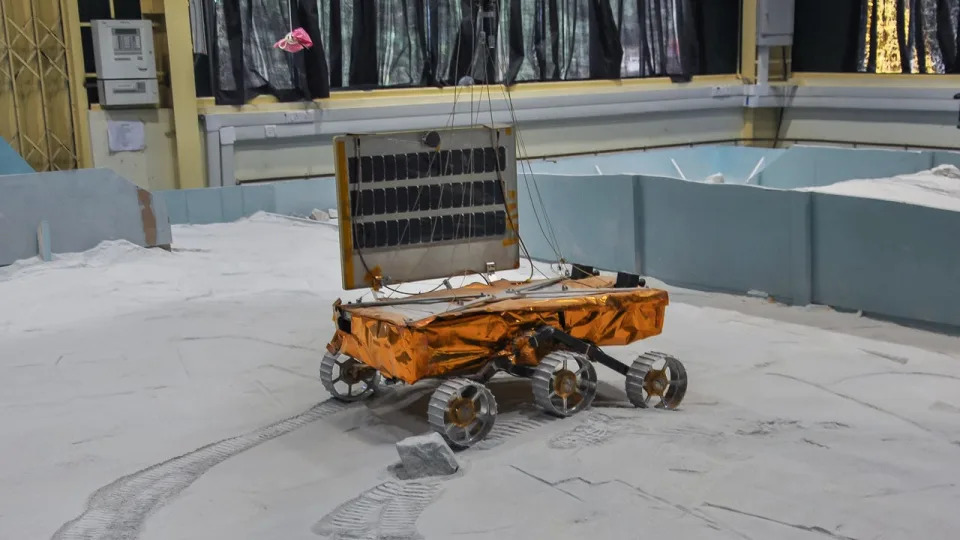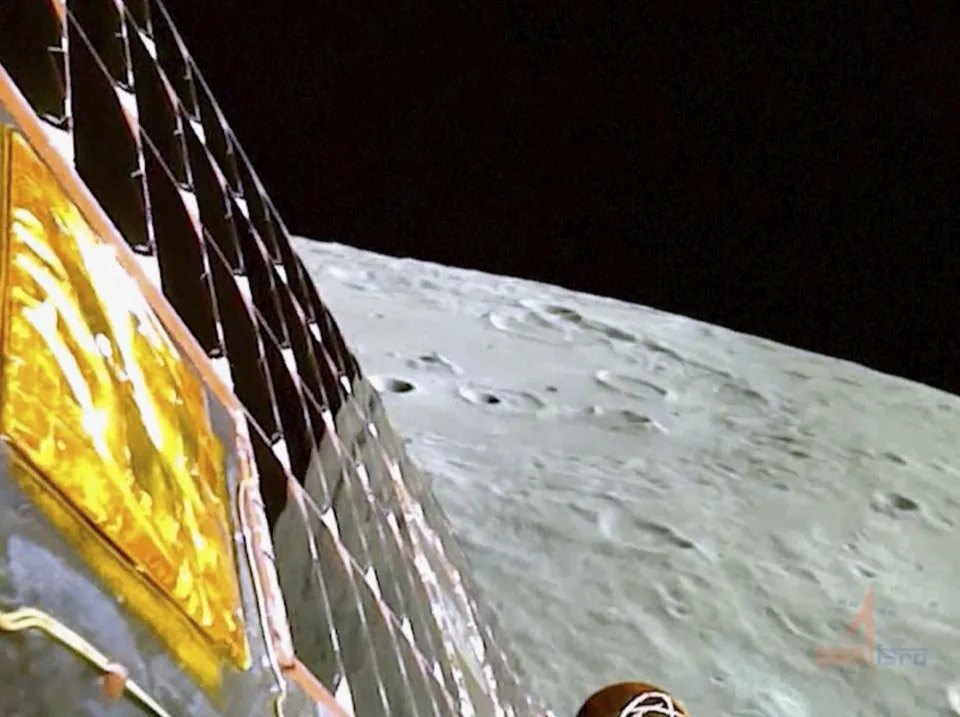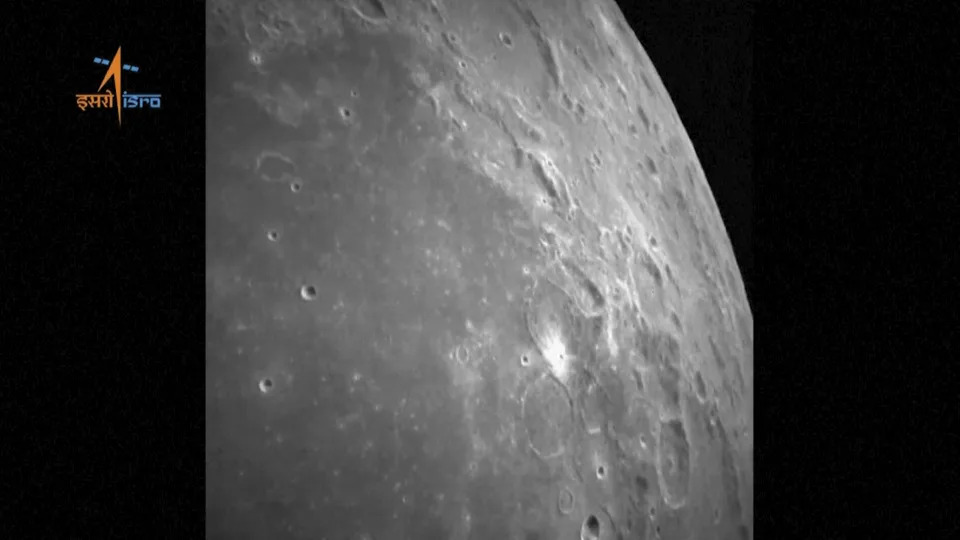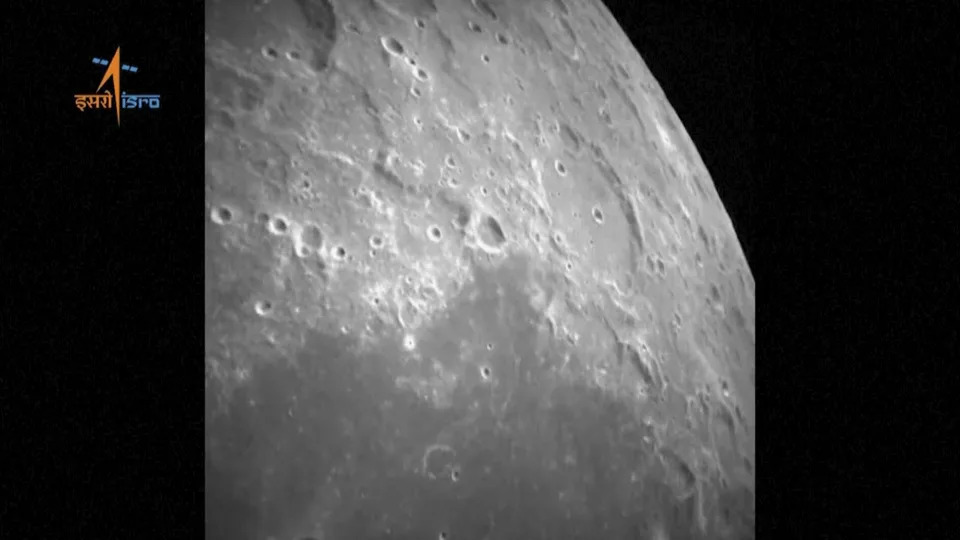Sonam Sheth,Morgan McFall-Johnsen
Tue, August 29, 2023

The Pragyaan rover will be the first robot to drive around on the lunar south pole. What will it find?
Indian Space Research Organization
India's moon rover made its first scientific observation on the lunar south pole.
The 57-pound rover is called Pragyaan — a Hindu name meaning one who possesses wisdom.
Pragyaan has confirmed the presence of sulfur as well as detected other elements.
India made history by becoming the first country to land successfully on the lunar south pole. And its lunar rover wasted no time in rolling out to make its first scientific observations.
On Tuesday, the Indian Space Research Organization announced on its website that the moon rover had confirmed the presence of sulphur. And preliminary analyses also suggest the presence of aluminum, calcium, iron, chromium, and titanium.
Suffice it to say, the rover's been busy. This adorable rover is called Pragyaan — a Hindu name meaning one who possesses greater knowledge and wisdom.
Pragyaan weighs 57 pounds, about the size of a small German shepherd or bull terrier, and it's spending two weeks driving where no robot or human has been before.
Pragyaan's science could be critical for learning how to mine moon water — a goal every moon-minded nation is eyeing.
The rover may be small and cute, but India's new moon mission "definitely puts them on the international stage as an emerging space power," Robert Braun, head of space exploration at Johns Hopkins Applied Physics Laboratory, told Insider.
What will India's moon rover do next?
It's equipped with a laser and an alpha-particle beam to help it study the composition of the lunar south pole, which is of particular interest.

The Vikram lander is the first robot to successfully land on the lunar south pole. Inside, it carried the Pragyaan lunar rover, which rolls out and down to the ground on the ramp shown here.
A moment for the history books
India is the fourth country — after Russia, the US, and China — to land on the moon.
"It's a huge achievement for the whole nation," Braun said. "Last time they got to the playoffs, if you will, and this time they won the Super Bowl."
"Everyone in the space community is joining with the nation of India, and their talented engineers and scientists, and celebrating their success and this achievement," he added
India Prevents Moon Rover From Falling Into Hole
Victor Tangermann
Tue, August 29, 2023

Close Call
Last week, India became only the fourth country to ever land on the Moon, with the Indian Space Research Organization (ISRO) proudly announcing its Vikram lander had safely touched down near the Moon's south pole.
It was a treacherous journey from lunar orbit, which many other countries haven't survived — like Russia, whose Luna-25 spacecraft crashed into the surface just a week prior.
Yet the lander and its much smaller rover companion Pragyaan, which rolled down a ramp to the surface below shortly after touchdown, are still in a hazardous off-world environment. In fact, the six-wheeled rover recently encountered an obstacle in the form of a ten-foot crater that seemingly threatened to swallow it whole.
Fortunately, ground control spotted the danger before it was too late.
"On August 27, 2023, the Rover came across a 4-meter diameter crater positioned 3 meters ahead of its location," ISRO wrote in a tweet. "The Rover was commanded to retrace the path. It's now safely heading on a new path."
India's moon rover made its first scientific observation on the lunar south pole.
The 57-pound rover is called Pragyaan — a Hindu name meaning one who possesses wisdom.
Pragyaan has confirmed the presence of sulfur as well as detected other elements.
India made history by becoming the first country to land successfully on the lunar south pole. And its lunar rover wasted no time in rolling out to make its first scientific observations.
On Tuesday, the Indian Space Research Organization announced on its website that the moon rover had confirmed the presence of sulphur. And preliminary analyses also suggest the presence of aluminum, calcium, iron, chromium, and titanium.
Suffice it to say, the rover's been busy. This adorable rover is called Pragyaan — a Hindu name meaning one who possesses greater knowledge and wisdom.
Pragyaan weighs 57 pounds, about the size of a small German shepherd or bull terrier, and it's spending two weeks driving where no robot or human has been before.
Pragyaan's science could be critical for learning how to mine moon water — a goal every moon-minded nation is eyeing.
The rover may be small and cute, but India's new moon mission "definitely puts them on the international stage as an emerging space power," Robert Braun, head of space exploration at Johns Hopkins Applied Physics Laboratory, told Insider.
What will India's moon rover do next?
It's equipped with a laser and an alpha-particle beam to help it study the composition of the lunar south pole, which is of particular interest.

The Vikram lander is the first robot to successfully land on the lunar south pole. Inside, it carried the Pragyaan lunar rover, which rolls out and down to the ground on the ramp shown here.
Indian Space Research Organisation
The lunar south pole is thought to be the most water-rich region on the moon. That's critical since water ice could be mined to produce breathable oxygen for future crewed lunar bases, as well as hydrogen and oxygen for rocket fuel that could propel future missions to Mars and beyond.
The rover will also use its RAMBHA and ILSA payloads on board to study the lunar atmosphere as well as dig up samples for additional analysis of the surface's composition, per Times of India.
But it was the rover's Laser-Induced Breakdown Spectroscopy (LIBS) instrument that ultimately made the first-ever measurements of the lunar south pole's composition, ISRO reported. The laser fires intense pulses at the lunar surface, which generates an extremely hot plasma.
That's where a trick of physics comes in handy: Each element on the periodic table emits a unique set of wavelengths of light. Scientists can study the light from the plasma to identify those wavelength sets and determine the chemical make-up of the stuff on the moon.
The lunar south pole is thought to be the most water-rich region on the moon. That's critical since water ice could be mined to produce breathable oxygen for future crewed lunar bases, as well as hydrogen and oxygen for rocket fuel that could propel future missions to Mars and beyond.
The rover will also use its RAMBHA and ILSA payloads on board to study the lunar atmosphere as well as dig up samples for additional analysis of the surface's composition, per Times of India.
But it was the rover's Laser-Induced Breakdown Spectroscopy (LIBS) instrument that ultimately made the first-ever measurements of the lunar south pole's composition, ISRO reported. The laser fires intense pulses at the lunar surface, which generates an extremely hot plasma.
That's where a trick of physics comes in handy: Each element on the periodic table emits a unique set of wavelengths of light. Scientists can study the light from the plasma to identify those wavelength sets and determine the chemical make-up of the stuff on the moon.
A moment for the history books
India is the fourth country — after Russia, the US, and China — to land on the moon.
"It's a huge achievement for the whole nation," Braun said. "Last time they got to the playoffs, if you will, and this time they won the Super Bowl."
"Everyone in the space community is joining with the nation of India, and their talented engineers and scientists, and celebrating their success and this achievement," he added
India Prevents Moon Rover From Falling Into Hole
Victor Tangermann
Tue, August 29, 2023

Close Call
Last week, India became only the fourth country to ever land on the Moon, with the Indian Space Research Organization (ISRO) proudly announcing its Vikram lander had safely touched down near the Moon's south pole.
It was a treacherous journey from lunar orbit, which many other countries haven't survived — like Russia, whose Luna-25 spacecraft crashed into the surface just a week prior.
Yet the lander and its much smaller rover companion Pragyaan, which rolled down a ramp to the surface below shortly after touchdown, are still in a hazardous off-world environment. In fact, the six-wheeled rover recently encountered an obstacle in the form of a ten-foot crater that seemingly threatened to swallow it whole.
Fortunately, ground control spotted the danger before it was too late.
"On August 27, 2023, the Rover came across a 4-meter diameter crater positioned 3 meters ahead of its location," ISRO wrote in a tweet. "The Rover was commanded to retrace the path. It's now safely heading on a new path."
https://twitter.com/isro/status/1696117102393081997?ref_src=twsrc%5Etfw%7Ctwcamp%5Etweetembed%7Ctwterm%5E1696117102393081997%7Ctwgr%5E78d3eb75d39e9e80902e55ae894a44d65f05d3d2%7Ctwcon%5Es1_&ref_url=https%3A%2F%2Fin.mashable.com%2Fspace%2F59137%2Fclose-call-indias-moon-rover-just-avoided-a-treacherous-craterHole Milk
The update also featured two glorious black-and-white images, one showing the deep and shadowed chasm that seemingly blocks the angled rays of the Sun. A second image shows Pragyaan's rover tracks.
Other than having India join the exclusive club of countries that have landed on the Moon — which also includes the US, the Soviet Union, and China — the country's ongoing Chandrayaan-3 mission also represents the first successful landing near the lunar south pole.
That's particularly exciting, as scientists suspect the region to be rich in water ice, which could make it a key site for future efforts to establish a long term presence on the lunar surface.
In short, let's hope the scientists at the ISRO keep their eyes peeled. Having Pragyaan tumble into a crater could make for a premature end to a groundbreaking mission.
More on the mission: Amazing Footage Shows Indian Rover Ramping Down to the Lunar Surface
India's moon rover confirms sulfur and detects several other elements near the lunar south pole
ASHOK SHARMA
Updated Tue, August 29, 2023




This image from video provided by the Indian Space Research Organisation shows the surface of the moon as the Chandrayaan-3 spacecraft prepares for landing on Wednesday, Aug. 23, 2023. India became the first country to land a spacecraft near the moon’s south pole, which scientists believe could hold vital reserves of frozen water. (ISRO via AP)
NEW DELHI (AP) — India’s moon rover confirmed the presence of sulfur and detected several other elements near the lunar south pole as it searches for signs of frozen water nearly a week after its historic moon landing, India’s space agency said Tuesday.
The rover's laser-induced spectroscope instrument also detected aluminum, iron, calcium, chromium, titanium, manganese, oxygen and silicon on the lunar surface, the Indian Space Research Organization, or ISRO, said in a post on its website.
The lunar rover had come down a ramp from the lander of India’s spacecraft after last Wednesday’s touchdown near the moon’s south pole. The Chandrayan-3 Rover is expected to conduct experiments over 14 days, the ISRO has said.
The rover "unambiguously confirms the presence of sulfur,” ISRO said. It also is searching for signs of frozen water that could help future astronaut missions, as a potential source of drinking water or to make rocket fuel.
The rover also will study the moon's atmosphere and seismic activity, ISRO Chairman S. Somnath said.
On Monday, the rover's route was reprogrammed when it came close to a 4-meter-wide (13-foot-wide) crater. "It’s now safely heading on a new path," the ISRO said.
The craft moves at a slow speed of around 10 centimeters (4 inches) per second to minimize shock and damage to the vehicle from the moon's rough terrain.
After a failed attempt to land on the moon in 2019, India last week joined the United States, the Soviet Union and China as only the fourth country to achieve this milestone.
The successful mission showcases India’s rising standing as a technology and space powerhouse and dovetails with the image that Prime Minister Narendra Modi is trying to project: an ascendant country asserting its place among the global elite.
The mission began more than a month ago at an estimated cost of $75 million.
India’s success came just days after Russia’s Luna-25, which was aiming for the same lunar region, spun into an uncontrolled orbit and crashed. It would have been the first successful Russian lunar landing after a gap of 47 years. Russia’s head of the state-controlled space corporation Roscosmos attributed the failure to the lack of expertise due to the long break in lunar research that followed the last Soviet mission to the moon in 1976.
Active since the 1960s, India has launched satellites for itself and other countries, and successfully put one in orbit around Mars in 2014. India is planning its first mission to the International Space Station next year, in collaboration with the United States.
No comments:
Post a Comment